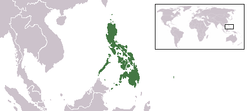Central Executive Committee Comité Ejecutivo Central | |||||||||||||
|---|---|---|---|---|---|---|---|---|---|---|---|---|---|
| 1898 | |||||||||||||
 Territory claimed by the Central Executive Committee in Asia | |||||||||||||
| Status | Unrecognized state | ||||||||||||
| Capital | unknown | ||||||||||||
| Common languages | Tagalog, Spanish | ||||||||||||
| Religion | Roman Catholicism, Islam | ||||||||||||
| Government | Provisional government | ||||||||||||
| Francisco Macabulos | |||||||||||||
| Historical era | Philippine Revolution | ||||||||||||
• Established | April 17, 1898 | ||||||||||||
| April 21, 1898 | |||||||||||||
| May 1, 1898 | |||||||||||||
| May 19, | |||||||||||||
| Currency | Philippine peso | ||||||||||||
| |||||||||||||
The Central Executive Committee (Spanish: Comité Ejecutivo Central; in modern Filipino: Komite ng Sentral na Tagapagpaganap) in the Philippines was an insurgent revolutionary government temporarily established by Francisco Macabulos on April 17, 1898, shortly after the December 14, 1897, signing of the Pact of Biak-na-Bato.[1] That pact established a truce between Spanish colonial authorities in the Philippines and the revolutionary Republic of Biak-na-Bato calling for the exile of Emilio Aguinaldo and other senior revolutionaries.[2] The exiled revolutionaries formed the Hong Kong Junta, and the Central Executive Committee was intended to remain in existence in the Philippines "until a general government of the Republic in these islands shall again be established, with a constitution which provided for a President, Vice President, Secretary of War and Secretary of the Treasury.."[2][3] The committee was dissolved shortly after Aguinaldo's May 19, 1898, return to the Philippines.
- ^ Agoncillo, Teodoro A. (1960). Malolos: The Crisis of the Republic. University of the Philippines. p. 65.
- ^ a b Agoncillo, Teodoro (1990) [First published 1960]. History of the Filipino People (8th ed.). R.P. Garcia Publishing Company. p. 185. ISBN 971-10-2415-2.
- ^ Zaide, Gregorio F. (1970). Philippine Constitutional History and Constitutions of Modern Nations: With Full Texts of the Constitutions of the Philippines and Other Modern Nations. Modern Book Co. p. 17.
